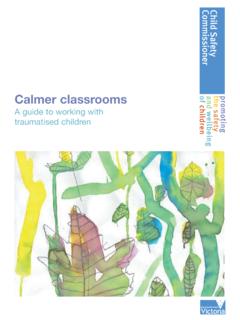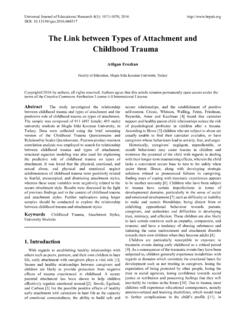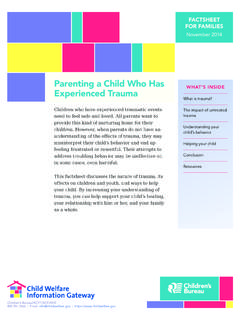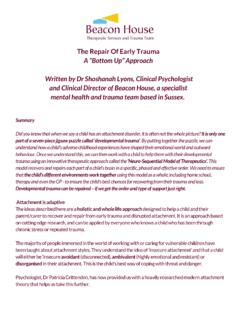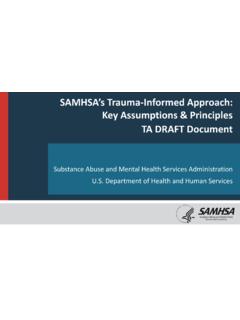Transcription of Leveraging the Best Available Evidence
1 Preventing Adverse childhood Experiences (ACEs): Leveraging the Best Available EvidenceNational Center for Injury Prevention and Control Division of Violence Prevention Preventing Adverse childhood Experiences (ACEs): Leveraging the Best Available Evidence1 Preventing Adverse childhood Experiences (ACEs): Leveraging the Best Available Evidence2019 Division of Violence PreventionNational Center for Injury Prevention and ControlCenters for Disease Control and PreventionAtlanta, Georgia2 Preventing Adverse childhood Experiences (ACEs): Leveraging the Best Available EvidenceNational Center for Injury Prevention and ControlDebra E. Houry, MD, MPH, DirectorDivision of Violence PreventionJames A.
2 Mercy, PhD, DirectorSuggested citation: Centers for Disease Control and Prevention (2019). Preventing Adverse childhood Experiences: Leveraging the Best Available Evidence . Atlanta, GA: National Center for Injury Prevention and Control, Centers for Disease Control and Prevention. Preventing Adverse childhood Experiences (ACEs): Leveraging the Best Available Evidence3 ContentsAcknowledgements ..5 What are Adverse childhood Experiences? ..7 Preventing ACEs is a priority for CDC ..7 What can be done to prevent ACEs? ..8 Strengthen Economic Supports for Families ..11 Promote Social Norms that Protect Against Violence and Adversity ..13 Ensure a Strong Start for Children ..15 Teach Skills ..17 Connect Youth to Caring Adults and Activities.
3 19 Intervene to Lessen Immediate and Long-term Harms ..21 Sector involvement ..23 Monitoring and evaluation ..25 Conclusion ..26 References ..27 Preventing Adverse childhood Experiences (ACEs): Leveraging the Best Available Evidence5 AcknowledgementsWe would like to acknowledge the following individuals who contributed to the development, review and support of this publication. First, we give special thanks to Linda Dahlberg for leading the development of this document. Second, we extend our gratitude to the many staff involved in the development of the CDC Technical Packages to Prevent Violence. These packages provided the foundation for this document. In particular, we thank the leads of the technical packages to prevent child abuse and neglect (Beverly Fortson, Joanne Klevens, and Melissa Merrick), sexual violence (Kathleen Basile and Sarah DeGue), intimate partner violence (Phyllis Niolon and Megan Kearns), youth violence (Corinne David-Ferdon), and suicide (Deborah Stone and Kristin Holland) for their insights, review, and contributions to this document.
4 We also thank Kathyrn Ports, Christopher Jones, Marilyn Metzler and Tamara Haegerich for generating ideas and offering many useful suggestions. Finally, we thank Alida Knuth for her assistance with graphics and layout and extend our gratitude to Division and Center leadership for their helpful feedback and support. Preventing Adverse childhood Experiences (ACEs): Leveraging the Best Available Evidence7 What are Adverse childhood Experiences? Adverse childhood Experiences, or ACEs, are potentially traumatic events that occur in childhood (0-17 years) such as experiencing violence, abuse, or neglect; witnessing violence in the home; and having a family member attempt or die by ,2 Also included are aspects of the child s environment that can undermine their sense of safety, stability, and bonding such as growing up in a household with substance misuse, mental health problems, or instability due to parental separation or incarceration of a parent, sibling or other member of the ,2 Traumatic events in childhood can be emotionally painful or distressing and can have effects that persist for Factors such as the nature, frequency and seriousness of the traumatic event, prior history of trauma .
5 And Available family and community supports can shape a child s response to Preventing ACEs is a priority for CDCAn estimated 62% of adults surveyed across 23 states reported that they had experienced one ACE during childhood and nearly one-quarter reported that they had experienced three or more ACEs can have negative, lasting effects on health, wellbeing, and opportunity. These exposures can disrupt healthy brain development, affect social development, compromise immune systems, and can lead to substance misuse and other unhealthy coping The Evidence confirms that these exposures increase the risks of injury, sexually transmitted infections, including HIV, mental health problems, maternal and child health problems, teen pregnancy, involvement in sex trafficking, a wide range of chronic diseases and the leading causes of death such as cancer, diabetes, heart disease, and ,10-16 ACEs can also negatively impact education, employment, and earnings The total economic and social costs to families, communities, and society is in the hundreds of billions of dollars each can have lasting effects (obesity, diabetes, depression, suicide attempts, STDs, heart disease, cancer.)
6 Stroke, COPD, broken bones)Behaviors (smoking, alcoholism, drug use)Life Potential (graduation rates, academic achievement, lost time from work)0012345>Risk for Negative Health and Well-being Outcomes# of ACESACEs have been found to have a graded dose-response relationship with 40+ outcomes to date.*This pattern holds for the 40+ outcomes, but the exact risk values vary depending on the Preventing Adverse childhood Experiences (ACEs): Leveraging the Best Available EvidenceHow ACEs influence health and opportunityThe childhood years, from the prenatal period to late adolescence, are the building block years that help set the stage for adult relationships, behaviors, health, and social outcomes. ACEs and associated conditions such as living in under-resourced or racially segregated neighborhoods, frequently moving, experiencing food insecurity, and other instability can cause toxic stress ( , prolonged activation of the stress-response system4).
7 Some children may face further exposure to toxic stress from historical and ongoing traumas due to systemic racism or the impacts of multigenerational poverty resulting from limited educational and economic opportunities. A large and growing body of research indicates that toxic stress during childhood can harm the most basic levels of the nervous, endocrine, and immune systems, and that such exposures can even alter the physical structure of DNA (epigenetic effects).4,5 Changes to the brain from toxic stress can affect such things as attention, impulsive behavior, decision-making, learning, emotion, and response to Absent factors that can prevent or reduce toxic stress, children growing up under these conditions often struggle to learn and complete ,22 They are at increased risk of becoming involved in crime and violence,23,24 using alcohol or drugs,6,7 and engaging in other health-risk behaviors ( , early initiation of sexual activity; unprotected sex; and suicide attempts).
8 9,13,16,23 They are susceptible to disease, illness, and mental health challenges over their ,14,15 Children growing up with toxic stress may have difficulty forming healthy and stable relationships. They may also have unstable work histories as adults and struggle with finances, family, jobs, and depression throughout life the effects of which can be passed on to their own ,12,17 Adverse childhood ExperiencesDisrupted neurodevelopmentSocial, emotional, and cognitive impairmentAdoption of health risk behaviorsImpacts on life potentialDisease, disability, and social problemsEarlydeathWhat can be done to prevent ACEs?ACEs and their associated harms are preventable. Creating and sustaining safe, stable, nurturing relationships and environments for all children and families can prevent ACEs and help all children reach their full health and life potential.
9 CDC has produced a suite of technical packages to help states and communities take advantage of the best Available Evidence to prevent violence, including the many types of violence and social, economic, and other exposures in the home and community that adversely affect children. 25-29 A technical package is a select group of strategies to achieve and sustain substantial reductions in a specific risk factor or Technical packages help communities and states prioritize prevention activities with the greatest potential for impact. A technical package has three parts. The first component is the strategy or the preventive direction or actions to achieve the goal of preventing ACEs. The second component is the approach. The approach includes the specific ways to advance the strategy. This can be accomplished through programs, practices, and policies.
10 The third component is the Evidence for each of the approaches in preventing ACEs or its associated risk factors. Preventing Adverse childhood Experiences (ACEs): Leveraging the Best Available Evidence9 Across the CDC Technical Packages there are several strategies that can prevent ACEs from happening in the first place as well as strategies to mitigate the harms of ACEs. The Evidence tells us that ACEs can be prevented by: Strengthening economic supports for families Promoting social norms that protect against violence and adversity Ensuring a strong start for children and paving the way for them to reach their full potential Teaching skills to help parents and youth handle stress, manage emotions.










